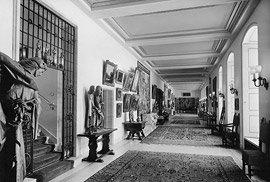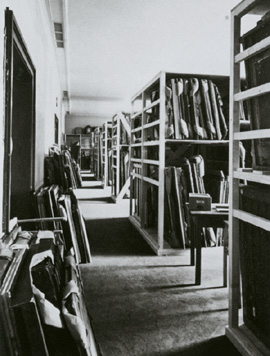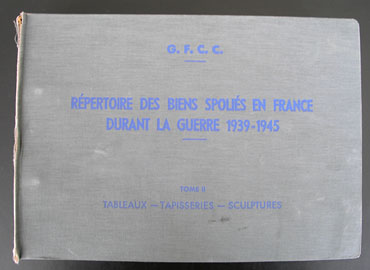
Carinhall
Beginning in 1936, Göring began turning his hunting lodge in the Schorfheide region north of Berlin into a baronial estate, which he called "Waldhof Carinhall" (Carinhall Forest Estate). He had a 34-meter long hall created, the so-called "Great Gallery," where he displayed the most important works of art in his collection.
See:

Central Art Collecting Point (CCP)
"Collecting Points" were what the United States Armed Forces called the places where artworks from storage facilities of looted art discovered in 1945 were registered, photographed, and restored. The most important Collecting Point was the Central Art Collecting Point in Munich.
The holdings of the "Führer Museum," Hermann Göring's collection, as well as the collections looted by the "Einsatzstab Reichsleiter Rosenberg" were stored here. Artworks from formerly occupied countries were restituted to these states with the proviso that they be returned to their original owners. Cultural assets confiscated by the National Socialists from German Jews were, in case they could be found, either returned to the former owners or their heirs.
Overall artworks from more than 600 German and Austrian storage sites were sent to the Collecting Point in Munich. The Americans handed their responsibility over to the German authorities in September 1949. Approximately 700,000 cultural assets were restituted between 1945 and 1951.
The Collecting Point began its operations on June 17, 1945. After which, truck convoys delivered crates containing paintings, sculptures, furniture and decorative arts. The building had to be closely guarded to protect the valuable artworks.
See:
Morris Raphael Cohen (1880-1947)
In addition to Salo W. Baron, the American philosopher and law professor Morris Raphael Cohen was also a founder of the CEJCR as well as the JCR. Their small staff drew up an overview of the Jewish cultural landscape in Europe before the war and made plans for reconstruction.
See:

Commission de Récupération Artistique (CRA)
In September 1944, the Commission de Récupération Artistique, the French Restitution Commission, was established. During the occupation period in Germany, the French Restitution Commission published a ten-volume listing of all goods looted in France. The volumes dealing with artworks served the purpose of informing museums and galleries. They were primarily distributed in Germany, Austria and France.Commission on European Jewish Cultural Reconstruction (CEJRC)
Salo W. Baron and Morris Cohen founded the successor organization CEJRC in 1944. Equipped with a small staff, its job was to make preparations for the possible reconstruction of Jewish cultural life in Europe after the war.
See:





